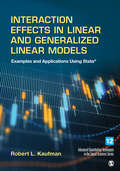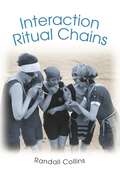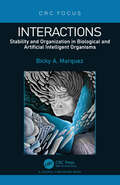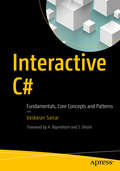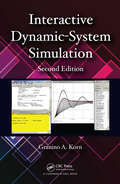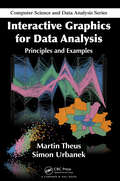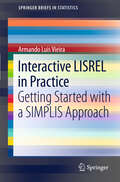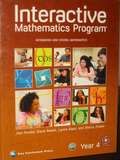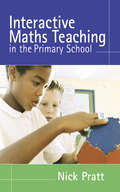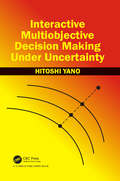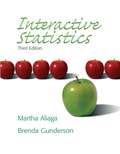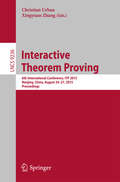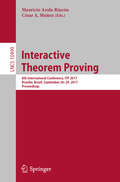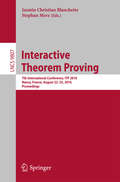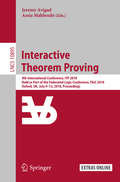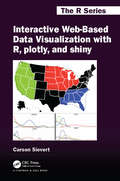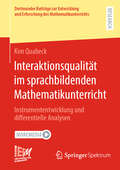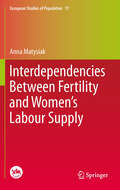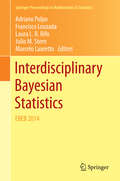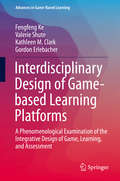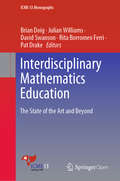- Table View
- List View
Interaction Effects in Linear and Generalized Linear Models: Examples and Applications Using Stata (Advanced Quantitative Techniques in the Social Sciences #12)
by Robert L. KaufmanOffering a clear set of workable examples with data and explanations, Interaction Effects in Linear and Generalized Linear Models is a comprehensive and accessible text that provides a unified approach to interpreting interaction effects. The book develops the statistical basis for the general principles of interpretive tools and applies them to a variety of examples, introduces the ICALC Toolkit for Stata (downloadable from the Robert L. Kaufman’s website), and offers a series of start-to-finish application examples to show students how to interpret interaction effects for a variety of different techniques of analysis, beginning with OLS regression. The data sets and the Stata code to reproduce the results of the application examples are available online.
Interaction Ritual Chains (Princeton Studies in Cultural Sociology #62)
by Randall CollinsSex, smoking, and social stratification are three very different social phenomena. And yet, argues sociologist Randall Collins, they and much else in our social lives are driven by a common force: interaction rituals. Interaction Ritual Chains is a major work of sociological theory that attempts to develop a "radical microsociology." It proposes that successful rituals create symbols of group membership and pump up individuals with emotional energy, while failed rituals drain emotional energy. Each person flows from situation to situation, drawn to those interactions where their cultural capital gives them the best emotional energy payoff. Thinking, too, can be explained by the internalization of conversations within the flow of situations; individual selves are thoroughly and continually social, constructed from the outside in. The first half of Interaction Ritual Chains is based on the classic analyses of Durkheim, Mead, and Goffman and draws on micro-sociological research on conversation, bodily rhythms, emotions, and intellectual creativity. The second half discusses how such activities as sex, smoking, and social stratification are shaped by interaction ritual chains. For example, the book addresses the emotional and symbolic nature of sexual exchanges of all sorts--from hand-holding to masturbation to sexual relationships with prostitutes--while describing the interaction rituals they involve. This book will appeal not only to psychologists, sociologists, and anthropologists, but to those in fields as diverse as human sexuality, religious studies, and literary theory.
Interactions: Stability and Organization in Biological and Artificial Intelligent Organisms
by Bicky A. MarquezThis book examines how predicting the future based on analytical and empirical models is essential for our species' survival, stable organization, and well-being. At a high level, information exchange, mainly through communication between people, fosters a deeper understanding of reality and strengthens human bonds, ultimately contributing to the emergence of societies as new creatures or "superorganisms" with significantly more data to feed those models. Communication is fundamental to the development of complex organisms, the maintenance of internal order, and the propagation of knowledge via cultural packets. The human brain's plasticity, memory, and learning capabilities enable storage and rapid responses to new information, enhancing our decision-making and forecasting abilities. The book discusses the complexity of multicellular organisms and the mechanisms that coordinate their internal subsystems, highlighting the emergence of hierarchies from fundamental particles to networks of superorganisms. The interconnectedness of biological oscillators with prominent similarities enables synchronization as a foundation for their superior organization and collective agreements. Finally, this book explores the human quest to enhance survival through accumulating knowledge and developing tools and technologies. It underscores the significance of artificial intelligence as a tool to support cognitive abilities and address global challenges while acknowledging our limited control over reality within an independently operating universe.
Interactive C#
by Vaskaran Sarcar[Announcement-Thanks for your interest in Interactive Object-Oriented Programming in C# and making this book as "No. 1 New Release". You motivated us to do some further modification and fine-tune this work. The heart of the book is Part-1 which focuses on Object-Oriented programming. But we are covering much more in this book and so, based on the readers feedback, we are bringing the upcoming and fine-tuned version of the book as "Interactive C#" very soon. You will be able to preorder the book shortly. So, stay tuned !!]Are you afraid of programming? Or, perhaps you experimented with some other programming languages and now want learn C#? Or, you want to learn fast but do not want to miss the key concepts? If the answer is yes for any of these questions, then you are at the right place. 1. The book consists of four major sections which cover 15 core topics - 9 of them are dedicated to object oriented programming, 5 of them are dedicated to advanced concepts of C#,1 of them is dedicated to design patterns which covers 3 Gang of Four design patterns with C# implementations. Finally, you will get a FAQ section to cover all of these. 2. Why do we put so much emphasis on the word "core"? It is because, world is changing and new features will keep evolving but core concepts are evergreen. All new features are built on top of those. If you have a strong foundation, you can adopt the upcoming features quickly because you can understand the reason behind those changes. So, the book focuses on core topics in depth but does not try to cover "a-z" in C# at the same time. 3. This book is interactive . With it, you can feel that you are learning in a classroom environment where your teacher is discussing some topics and asking you questions. At the same time, you can clear your doubts by asking counter questions. It is very much important because many students cannot ask questions in an open forum due to many psychological factors. If you are dedicated to this subject and repeatedly think about these Q&A sessions, you can remake yourself in the programming world. 4. This book will not invest time on topics that are easily available e. g. how to install visual studio in your system or how to write a "hello world' program etc. On the contrary, the book contains a section that provides some fundamental theories with some interesting questions/answers in the topics like-IL code, selection, iteration and jump statements, arrays, strings, structures ,enumerations etc. , so that ,you can learn and evaluate your skills in those topics. This section will act like a reference. Gradually upon repeated practice, you will be familiar with it. This section will also help you to prepare yourself before a job interview or a semester examination to answer some tricky questions that may seem to be very easy at the beginning. Your teacher only expects that before you enter into the class, you must aware of the basic syntax's/notations. 5. In most of the cases, you'll see the complete programs with output snapshots (for different inputs) i. e. You do not need to wait to run a program to see the corresponding outputs. Programs were run both in windows 7 and 10 and snapshots are taken from visual studio community 2017 edition which is free (and latest) at the time of this writing. 6. Lastly, many of us are afraid of fat books because they do not show us the promise that we can learn it in one day or 7 days etc. but they forget that learning is a continuous process. Author also believes that no real mastery can be achieved in 24 hrs or in 7 days. So, the slogan of the book is "To learn the core topics in C#, whatever efforts I need to put, I am OK with that". Still simple arithmetic says that if you can complete 2 topics per week, you can complete the book by 2 months . The book is designed for you in such a way that upon completion of the book, you will learn the core OOP concepts in C# in details how to go further.
Interactive Data Processing and 3D Visualization of the Solid Earth
by Daniel PatelThis book presents works detailing the application of processing and visualization techniques for analyzing the Earth’s subsurface. The topic of the book is interactive data processing and interactive 3D visualization techniques used on subsurface data. Interactive processing of data together with interactive visualization is a powerful combination which has in the recent years become possible due to hardware and algorithm advances in. The combination enables the user to perform interactive exploration and filtering of datasets while simultaneously visualizing the results so that insights can be made immediately. This makes it possible to quickly form hypotheses and draw conclusions. Case studies from the geosciences are not as often presented in the scientific visualization and computer graphics community as e.g., studies on medical, biological or chemical data. This book will give researchers in the field of visualization and computer graphics valuable insight into the open visualization challenges in the geosciences, and how certain problems are currently solved using domain specific processing and visualization techniques. Conversely, readers from the geosciences will gain valuable insight into relevant visualization and interactive processing techniques. Subsurface data has interesting characteristics such as its solid nature, large range of scales and high degree of uncertainty, which makes it challenging to visualize with standard methods. It is also noteworthy that parallel fields of research have taken place in geosciences and in computer graphics, with different terminology when it comes to representing geometry, describing terrains, interpolating data and (example-based) synthesis of data. The domains covered in this book are geology, digital terrains, seismic data, reservoir visualization and CO2 storage. The technologies covered are 3D visualization, visualization of large datasets, 3D modelling, machine learning, virtual reality, seismic interpretation and multidisciplinary collaboration. People within any of these domains and technologies are potential readers of the book.
Interactive Dynamic-System Simulation (Numerical Insights)
by Granino A. KornShowing you how to use personal computers for modeling and simulation, Interactive Dynamic-System Simulation, Second Edition provides a practical tutorial on interactive dynamic-system modeling and simulation. It discusses how to effectively simulate dynamical systems, such as aerospace vehicles, power plants, chemical processes, control systems, and physiological systems.Written by a pioneer in simulation, the book introduces dynamic-system models and explains how software for solving differential equations works. After demonstrating real simulation programs with simple examples, the author integrates a new treatment of the difference equation programs needed to model sampled-data control systems with digital controllers. Subsequent chapters provide detailed programming know-how. These chapters cover library, table-lookup, user-definable, limiter, switching, and noise functions; an experiment-protocol scripting language; powerful vector and matrix operations; and classical simulation programs that illustrate a number of useful programming tricks. The final chapter shows how experiment-protocol scripts and compiled DYNAMIC program segments can quickly solve mathematical problems, including fast graph plotting, Fourier transforms, and complex-number plots.Downloadable ResourcesThe accompanying downloadable resources contain a complete, industrial-strength simulation program package. To install the ready-to-run simulation system, simply copy a single Windows or Linux folder from the downloadable resources. You can then run and modify every program example in the text or try your own projects. For truly interactive modeling, screen-edited programs are run-time compiled and immediately produce solution displays on a typed run command.
Interactive Graphics for Data Analysis: Principles and Examples
by Martin Theus Simon UrbanekInteractive Graphics for Data Analysis: Principles and Examples discusses exploratory data analysis (EDA) and how interactive graphical methods can help gain insights as well as generate new questions and hypotheses from datasets.Fundamentals of Interactive Statistical GraphicsThe first part of the book summarizes principles and methodology, demons
Interactive LISREL in Practice: Getting Started with a SIMPLIS Approach
by Armando Luis Vieira"Getting Started with a SIMPLIS Approach" is particularly appropriate for those users who are not experts in statistics, but have a basic understanding of multivariate analysis that would allow them to use this handbook as a good first foray into LISREL. Part I introduces the topic, presents the study that serves as the background for the explanation of matters, and provides the basis for Parts II and III, which, in turn, explain the process of estimation of the measurement model and the structural model, respectively. In each section, we also suggest essential literature to support the utilization of the handbook. After having read the book, readers will have acquired a basic knowledge of structural equation modeling, namely using the LISREL program, and will be prepared to continue with the learning process.
Interactive Mathematics Program: Integrated High School Mathematics, Year 2
by Juan Alvarez Dan Fendel Diane Resek Sherry Fraser Tom Fowler Evangelia Philippidis Sharon Taylor Lynne AlperNIMAC-sourced textbook
Interactive Mathematics Program: Integrated High School Mathematics, Year 2
by Dan Fendel Diane Resek Sherry Fraser Lynne AlperNIMAC-sourced textbook
Interactive Mathematics Program: Integrated High School Mathematics, Year 4 (Baker's Choice)
by Juan Alvarez Dan Fendel Diane Resek Tom Fowler Lynne Alper Mali Apple Alan Dubinsky Josephine NoahNIMAC-sourced textbook
Interactive Maths Teaching in the Primary School
by Dr Nick Pratt'Nick Pratt's book looks in detail at the real meaning of teaching mathematics interactively in primary schools. Each section is set clearly within a context, is linked by 'key ideas' - the important bits to think about - and is summarised to give a succinct close to the chapter's content and thinking. It is a book that the reader will definitely find useful and thought provoking. It certainly made me consider how small changes and a wider variety of approaches in the classroom can make big changes in children's learning and understanding of mathematical concepts' - Mike Eatwell, Primary Maths Advisor, Bristol LEA Using a whole-class, interactive approach to teaching mathematics is a key feature of the National Numeracy Strategy (NNS), and this book looks at not only what works but also why things work. Teachers will be able to understand why and how the various teaching strategies they are using in their classrooms have a positive effect on children's learning. The book covers: " how to engage in meaningful reflective practice that will improve your lessons " how to use whiteboards " making mathematical meaning through talk " getting the whole class interacting " thinking, talking and acting mathematically " teaching number - starting points " teaching shape and space - starting points " developing your interactive teaching " a glossary of terms It is aimed at both practising and trainee teachers, and offers clear subject guidance as well as an explanation of a key part of the NNS. It supports both individuals and mathematics subject leaders delivering INSET to their colleagues.
Interactive Multiobjective Decision Making Under Uncertainty
by Hitoshi YanoRecently, many books on multiobjective programming have been published. However, only a few books have been published, in which multiobjective programming under the randomness and the fuzziness are investigated. On the other hand, several books on multilevel programming have been published, in which multiple decision makers are involved in hierarchical decision situations. In this book, we introduce the latest advances in the field of multiobjective programming and multilevel programming under uncertainty. The reader can immediately use proposed methods to solve multiobjective programming and multilevel programming, which are based on linear programming or convex programming technique. Organization of each capter is summarized as follows. In Chapter 2, multiobjective programming problems with random variables are formulated, and the corresponding interactive algorithms are developed to obtain a satisfactory solution, in which the fuzziness of human's subjective judgment for permission levels are considered. In Chapter 3, multiobjective programming problems with fuzzy random variables are formulated, and the corresponding interactive algorithms are developed to obtain a satisfactory solution, in which not only the uncertainty of fuzzy random variables but also the fuzziness of human's subjective judgment for permission levels are considered. In Chapter 4, multiobjective multilevel programming is discussed, and the interactive algorithms are developed to obtain a satisfactory solution, in which the hierarchical decision structure of multiple decision makers is reflected. In Chapter 5, two kinds of farm planning problems are solved by applying the proposed method, in which cost coefficients of crops are expressed by random variables.
Interactive Statistics (Third Edition)
by Martha Aliaga Brenda GundersonThis volume takes a hands-on approach to the introduction of basic statistical methods, using a highly interactive method. Readers are taught to ask "why" and think like a statistician to find the logical solution. With its strong emphasis on data analysis, the book gives readers the skills to understand and interpret a variety of statistical results. Provides an overview of the basic components of decision-making and using statistical ideas. Helps readers master the language of statistics, the importance of a p-value, and the meaning of statistical significance. Includes coverage of current topics such as power of the test and effect size, bootstrap, and blocking designs in experiments. Uses examples from business, sports, economics, and more to address a wide range of interests. Includes chapter-ending TI Quick Steps for using calculators to enter, manipulate, and plot data. For anyone interested in learning more about statistics.
Interactive Theorem Proving
by Christian Urban Xingyuan ZhangThis book constitutes the proceedings of the 6th International Conference on Interactive Theorem Proving, ITP 2015, held in Nanjing, China, in August 2015. The 27 papers presented in this volume were carefully reviewed and selected from 54 submissions. The topics range from theoretical foundations to implementation aspects and applications in program verification, security and formalization of mathematics.
Interactive Theorem Proving
by Mauricio Ayala-Rincón César A. MuñozThis book constitutes the refereed proceedings of the 8th International Conference on Interactive Theorem Proving, ITP 2017, held in Brasilia, Brazil, in September 2017. The 28 full papers, 2 rough diamond papers, and 3 invited talk papers presented were carefully reviewed and selected from 65 submissions. The topics range from theoretical foundations to implementation aspects and applications in program verification, security and formalization of mathematical theories.
Interactive Theorem Proving
by Stephan Merz Jasmin Christian BlanchetteThis book constitutes the refereed proceedings of the 7th International Conference on Interactive Theorem Proving, ITP 2016, held in Nancy, France, in August 2016. The 27 full papers and 5 short papers presented were carefully reviewed and selected from 55 submissions. The topics range from theoretical foundations to implementation aspects and applications in program verification, security and formalization of mathematical theories.
Interactive Theorem Proving: 9th International Conference, ITP 2018, Held as Part of the Federated Logic Conference, FloC 2018, Oxford, UK, July 9-12, 2018, Proceedings (Lecture Notes in Computer Science #10895)
by Jeremy Avigad Assia MahboubiThis book constitutes the refereed proceedings of the 9th International Conference on Interactive Theorem Proving, ITP 2018, held in Oxford, UK, in July 2018.The 32 full papers and 5 short papers presented were carefully reviewed and selected from 65 submissions. The papers feature research in the area of logical frameworks and interactive proof assistants. The topics include theoretical foundations and implementation aspects of the technology, as well as applications to verifying hardware and software systems to ensure their safety and security, and applications to the formal verication of mathematical results.Chapters 2, 10, 26, 29, 30 and 37 are available open access under a Creative Commons Attribution 4.0 International License via link.springer.com.
Interactive Web-Based Data Visualization with R, plotly, and shiny (Chapman & Hall/CRC The R Series)
by Carson SievertThe richly illustrated Interactive Web-Based Data Visualization with R, plotly, and shiny focuses on the process of programming interactive web graphics for multidimensional data analysis. It is written for the data analyst who wants to leverage the capabilities of interactive web graphics without having to learn web programming. Through many R code examples, you will learn how to tap the extensive functionality of these tools to enhance the presentation and exploration of data. By mastering these concepts and tools, you will impress your colleagues with your ability to quickly generate more informative, engaging, and reproducible interactive graphics using free and open source software that you can share over email, export to pdf, and more. Key Features: Convert static ggplot2 graphics to an interactive web-based form Link, animate, and arrange multiple plots in standalone HTML from R Embed, modify, and respond to plotly graphics in a shiny app Learn best practices for visualizing continuous, discrete, and multivariate data Learn numerous ways to visualize geo-spatial data This book makes heavy use of plotly for graphical rendering, but you will also learn about other R packages that support different phases of a data science workflow, such as tidyr, dplyr, and tidyverse. Along the way, you will gain insight into best practices for visualization of high-dimensional data, statistical graphics, and graphical perception. The printed book is complemented by an interactive website where readers can view movies demonstrating the examples and interact with graphics.
Interaktionen von Lehrpersonen mit Mädchen und Jungen im Mathematikunterricht der Grundschule: Geschlechtsspezifische Unterschiede und Zusammenhänge mit der Selbstkonzeptentwicklung
by Ann-Katrin DennMithilfe videobasierter Beobachtungen geht Ann-Katrin Denn in diesem Buch der Frage nach, ob Mädchen und Jungen im Unterrichtsgespräch des Mathematikunterrichts in der Grundschule von Lehrpersonen unterschiedlich eingebunden werden (bspw. durch Fragen, Aufrufe oder Feedback). Aufgrund der geschlechtsspezifischen Unterschiede im mathematischen Selbstkonzept wird außerdem untersucht, ob sich Aspekte der Interaktion unterschiedlich auf die Selbstkonzeptentwicklung von Mädchen und Jungen auswirken.
Interaktionsqualität im sprachbildenden Mathematikunterricht: Instrumententwicklung und differentielle Analysen (Dortmunder Beiträge zur Entwicklung und Erforschung des Mathematikunterrichts #2)
by Kim QuabeckEin reichhaltiger, sprachbildender Mathematikunterricht lässt sich nicht allein durch sorgfältig designte Aufgaben herstellen, denn die fachlichen und sprachlichen Lerngelegenheiten ergeben sich vor allem auch in der Interaktion zwischen Lehrkräften und Lernenden. Diese hohe Relevanz der Interaktionsqualität ist in qualitativen Fallstudien vielfach belegt, doch nach wie vor wird Interaktionsqualität in quantitativen Studien der Unterrichtsqualitätsforschung noch unsystematisch und mit sehr heterogenen Konzeptualisierungen und Operationalisierungen erfasst. In diesem Buch widmet sich die Autorin dieser Forschungslücke, indem ein sehr hoch auflösendes Analyseinstrument für Interaktionsqualität theoriebasiert entwickelt und beforscht wird. Mittels differentieller Analysen wird des Weiteren der Zusammenhang zwischen Lernmilieus und Lernvoraussetzungen für Interaktionsqualität untersucht.
Interdependencies Between Fertility and Women's Labour Supply
by Anna MatysiakThe book explores interlinkages between women's employment and fertility at both a macro- and a micro-level in EU member states, Norway and Switzerland. Similarly as many other studies on the topic, it refers to the cross-country variation in the macro-context for explaining cross-country differences in women's labour supply and fertility levels. However, in contrast to other studies, which mainly focus on Western Europe, it extends the discussion to Central and Eastern European countries. Furthermore, it looks at the macro-context from a multi-dimensional perspective, indicating its four dimensions as relevant for fertility and women's employment choices: economic (living standards), institutional (family policies), structural (labour market structures), and cultural (social norms). A unique feature of the study is the development of indices that measure the intensity of institutional, structural, and cultural incompatibilities between women's employment and fertility. These indices are used for ranking European countries from the perspective of the country-specific conditions for work and family reconciliation. A country where these conditions are the worst, but where women are additionally perceived as important income providers, is picked up for an in-depth empirical study of the interrelationship between fertility and women's employment choices. Finally, against the review of theoretical concepts predominantly used for studying interdependencies between fertility and women's labour supply the book assesses the micro-level empirical studies available on the topic and proposes an analytical approach for modelling the two variables. Thereby, it also contributes to methodological developments in the field.
Interdisciplinary Bayesian Statistics
by Adriano Polpo Francisco Louzada Laura L. R. Rifo Julio M. Stern Marcelo LaurettoThrough refereed papers, this volume focuses on the foundations of the Bayesian paradigm; their comparison to objectivistic or frequentist Statistics counterparts; and the appropriate application of Bayesian foundations. This research in Bayesian Statistics is applicable to data analysis in biostatistics, clinical trials, law, engineering, and the social sciences. EBEB, the Brazilian Meeting on Bayesian Statistics, is held every two years by the ISBrA, the International Society for Bayesian Analysis, one of the most active chapters of the ISBA. The 12th meeting took place March 10-14, 2014 in Atibaia. Interest in foundations of inductive Statistics has grown recently in accordance with the increasing availability of Bayesian methodological alternatives. Scientists need to deal with the ever more difficult choice of the optimal method to apply to their problem. This volume shows how Bayes can be the answer. The examination and discussion on the foundations work towards the goal of proper application of Bayesian methods by the scientific community. Individual papers range in focus from posterior distributions for non-dominated models, to combining optimization and randomization approaches for the design of clinical trials, and classification of archaeological fragments with Bayesian networks.
Interdisciplinary Design of Game-based Learning Platforms: A Phenomenological Examination of the Integrative Design of Game, Learning, and Assessment (Advances in Game-Based Learning)
by Fengfeng Ke Kathleen M. Clark Valerie Shute Gordon ErlebacherThis book represents a four-year research and development project. It presents a phenomenological examination and explanation of a functional design framework for games in education. It furnishes a rich description of the experiences and perceptions of performing interdisciplinary collaborative design among experts of very diverse fields, such as learning systems design, architectural design, assessment design, mathematics education, and scientific computing.
Interdisciplinary Mathematics Education: A State Of The Art (ICME-13 Monographs)
by David Swanson Julian Williams Brian Doig Rita Borromeo Ferri Pat DrakeThis open access book is the first major publication on the topic of “Interdisciplinary Mathematics Education” and arose from the work of the first International Topic Study Group of the same name at the ICME-13 conference in Hamburg in 2016. It offers extensive theoretical insights, empirical research, and practitioner accounts of interdisciplinary mathematics work in STEM and beyond (e.g. in music and the arts). <P><P> Scholars and practitioners from four continents contributed to this comprehensive book, and present studies on: the conceptualizations of interdisciplinarity; implementation cases at schools and tertiary institutions; teacher education; and implications for policy and practice. Each chapter, and the book itself, closes with an assessment of the most significant aspects that those involved in policy and practice, as well as future researchers, should take into account.
